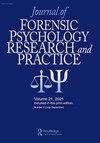促进司法精神病学的共同决策:HKT-R Spider应用程序
IF 1.1
4区 心理学
Q4 CRIMINOLOGY & PENOLOGY
Journal of Forensic Psychology Research and Practice
Pub Date : 2022-01-24
DOI:10.1080/24732850.2022.2028394
引用次数: 0
摘要
历史临床未来修订[HKT-R]是一个风险评估工具,以支持法医精神病学专业人员的临床决策,以防止未来的再犯。我们与病人和专业人士共同开发了一个自我报告版本和应用程序,即所谓的HKT-R蜘蛛应用程序。这个应用程序旨在帮助病人了解他们与犯罪有关的风险和保护因素,并更多地参与治疗。通过比较患者对14项临床和7项未来相关因素的自我报告与工作人员的观察,该应用程序旨在促进共同决策。在这项研究中,我们检查了患者(n = 32)和工作人员(n = 8)对风险和保护因素的看法是否一致或不同。确切的一致性很低。专家评估患者在8项临床因素和4项未来HKT-R因素上的风险显著增加。患者评估自己患精神病的风险明显更高。得分相关性从负向到高向不等。使用可视化的HKT-Spider应用程序,可以作为患者和专业人员交流的开始和工具,共同制定个性化的决策。它使治疗轨迹可视化。患者报告说,该应用程序是用户友好,信息丰富,有用的对话与他们的专业人员。需要在法医领域进一步实施。本文章由计算机程序翻译,如有差异,请以英文原文为准。
Facilitating Shared Decision Making in Forensic Psychiatry: The HKT-R Spider App
ABSTRACT The Historical Clinical Future-Revised [HKT-R] is a risk assessment tool to support forensic psychiatric professionals in their clinical decisions to prevent future recidivism. A self-report version and App has been developed in co-creation with patients and professionals, the so-called HKT-R Spider App. This App aims to helps patients understand their offense-related risk- and protective factors and become more involved in their treatment. By comparing patient’s self-reports on 14 clinical and seven future-related factors with staff observations, this App aims to facilitate shared decision making. In this study, we examined whether perceptions of risk and protective factors between patients (n = 32) and staff (n = 8) corresponded or differed. Exact agreement was low. Professionals assessed patients significantly higher at risk for eight clinical and four future HKT-R factors. Patients assessed themselves significantly more at risk for psychosis. Score correlations ranged from negative to high-strong. The use of the visual HKT-Spider App is promising as a conversation starter and tool for patients and professionals for shared personalized decision making. It visualizes a treatment trajectory. Patients report that the App is user friendly, informative and useful in the dialogue with their professionals. Further implementation in the forensic field is needed.
求助全文
通过发布文献求助,成功后即可免费获取论文全文。
去求助
来源期刊
CiteScore
1.80
自引率
12.50%
发文量
53

 求助内容:
求助内容: 应助结果提醒方式:
应助结果提醒方式:


